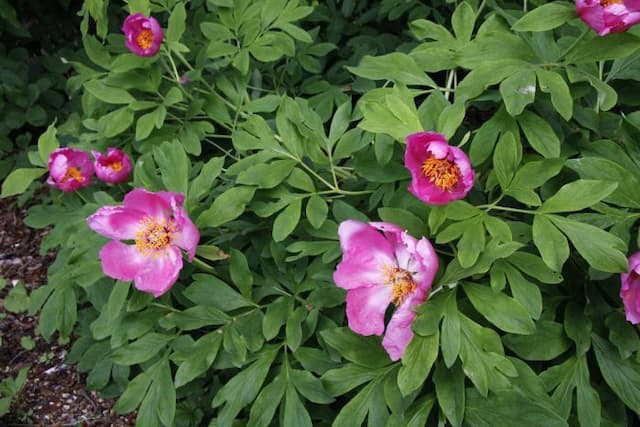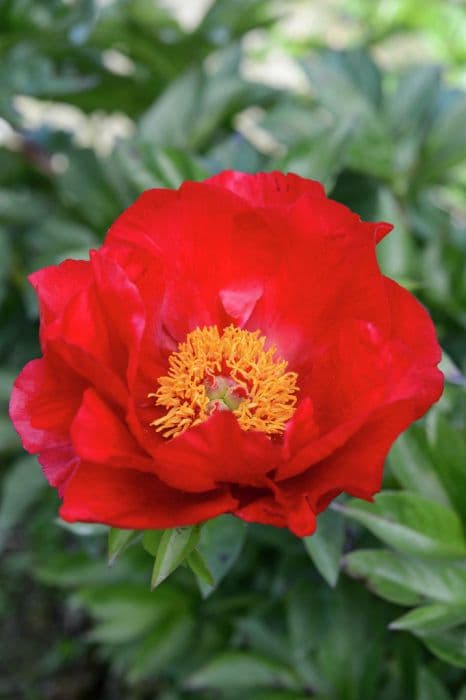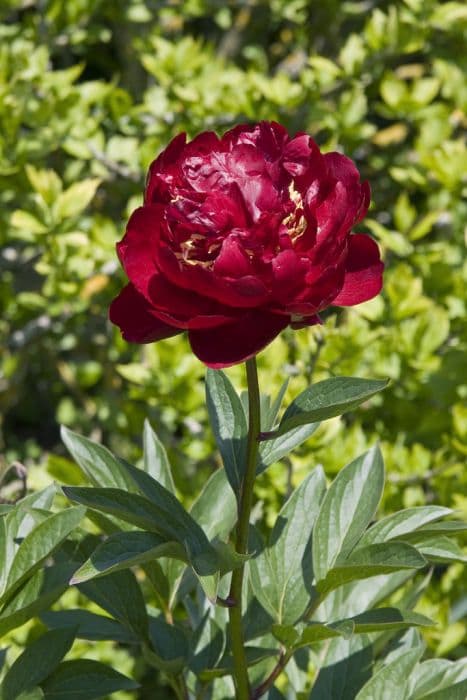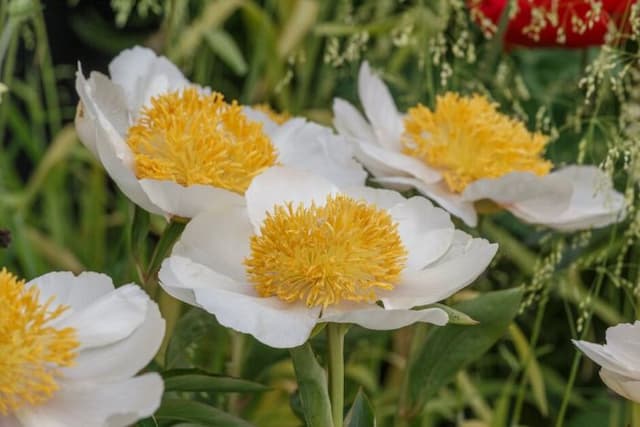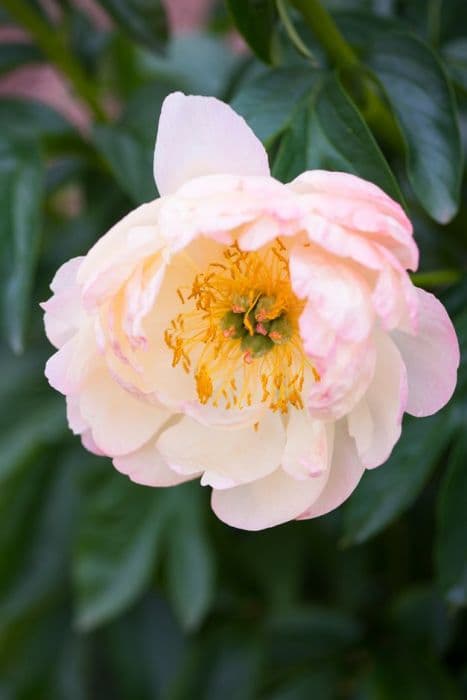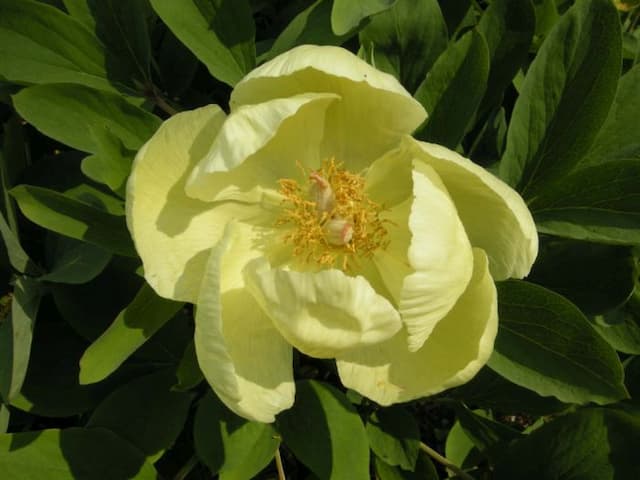Chinese Peony Paeonia lactiflora 'Bessie'

ABOUT
Paeonia lactiflora 'Bessie', commonly known as Chinese peony 'Bessie', is a beautiful herbaceous perennial plant that showcases lush, dark green foliage with a glossy appearance. The leaves are divided into leaflets, which are further segmented into lobed or serrated margins, giving them a delicate, ornamental look. The plant is renowned for its large, showy flowers that bloom in late spring to early summer. The flowers of 'Bessie' are particularly striking. They are double blooms, meaning they have multiple layers of petals, creating a full and ruffled effect. Each blossom displays an exquisite array of soft pink petals that can sometimes have a paler or almost white hue at their edges, adding to their depth and charm. The blooms are wonderfully scented, exuding a sweet and inviting fragrance that can attract garden visitors and beneficial pollinators alike. At the center of each flower, a tuft of small golden-yellow stamens may be visible, providing a striking contrast against the soft pink petals. The overall effect is one of classic elegance and romance, making the Chinese peony 'Bessie' a highly sought after variety for gardeners looking to add a touch of timeless beauty to their landscapes.
About this plant
 Names
NamesFamily
Paeoniaceae
Synonyms
Chinese Peony, Common Garden Peony
Common names
Paeonia lactiflora 'Bessie'.
 Toxicity
ToxicityTo humans
Paeonia lactiflora, commonly known as the peony, is not considered highly toxic to humans. Ingesting parts of the plant, particularly in large quantities, may cause mild stomach upset, but significant toxicity is rare. Contact with the skin may sometimes cause irritation in sensitive individuals. As with any plant material, it's wise to exercise caution and keep peonies out of the reach of young children who might ingest plant parts out of curiosity.
To pets
Peonies, including Paeonia lactiflora 'Bessie', are considered toxic to pets such as dogs and cats. If a pet ingests parts of a peony plant, they may exhibit symptoms of gastrointestinal upset including vomiting and diarrhea. In some cases, a pet may also experience lethargy or a lack of coordination. It is recommended to prevent pets from accessing these plants, and if ingestion occurs, to consult with a veterinarian promptly.
 Characteristics
CharacteristicsLife cycle
Perennials
Foliage type
Deciduous
Color of leaves
Green
Flower color
Pink
Height
2-3 feet (0.6-0.9 m)
Spread
2-3 feet (0.6-0.9 m)
Plant type
Herbaceous
Hardiness zones
3-8
Native area
Asia
Benefits
 General Benefits
General Benefits- Aesthetic Appeal: This plant, commonly known as Chinese peony, provides beautiful blooms that can enhance the visual appeal of gardens and landscapes.
- Attracts Pollinators: The flowers can attract bees, butterflies, and other beneficial insects, supporting local ecosystems.
- Variety of Uses: Chinese peony can be used in flower beds, as a border plant, or in cut flower arrangements due to its attractive and large blooms.
- Durable: It is known for its hardiness and can thrive in a range of climates with proper care.
- Seasonal Interest: Blooming in late spring to early summer, Chinese peony adds seasonal interest to gardens when many other plants may not be in bloom.
- Low Maintenance: Once established, it requires minimal care beyond basic watering and occasional fertilizing.
- Long Lived: With proper care, Chinese peonies can live and flourish for many years, even decades, making them a good investment for a garden.
- Symbolic Significance: In some cultures, peonies symbolize riches and honor, which can add emotional and cultural value to a garden.
 Medical Properties
Medical Properties- Anti-inflammatory: Paeonia lactiflora has been used in traditional medicine for its anti-inflammatory properties.
- Antispasmodic: It is believed to help relax muscle tissue and reduce spasms.
- Anxiolytic: Some components in Paeonia lactiflora may have a mild sedative effect that helps alleviate anxiety.
- Immunomodulatory: The root of Paeonia lactiflora may influence the immune system, potentially enhancing immune response.
- Antioxidant: Contains compounds that are thought to have antioxidant effects, helping to protect cells from damage.
- No use for pain relief: Despite traditional uses, there is no strong evidence to support the pain-relieving properties of Paeonia lactiflora 'Bessie'.
- No cardiovascular benefits: There are no well-documented cardiovascular benefits associated with this plant's use.
 Air-purifying Qualities
Air-purifying QualitiesThis plant is not specifically known for air purifying qualities.
 Other Uses
Other Uses- Paeonia lactiflora, commonly known as the Chinese peony, can be used to create natural dyes for fabrics, with the petals providing a range of colors depending on the mordant used.
- The strong stems of the Chinese peony can be incorporated into floral crafts such as wreath-making for their durability and beauty.
- Petals of the Chinese peony are edible and can add a bright visual element to gourmet dishes such as salads or as delicate garnishes on desserts.
- In perfumery, the Chinese peony's fragrance can be used to create sweet, floral scents, and is sometimes featured in high-end perfumes.
- The plant's seeds can be pressed to produce an oil, which is occasionally used in the making of traditional soaps and lotions for its moisturizing properties.
- Dried Chinese peony petals can be incorporated into potpourris to add a pleasant aroma to indoor spaces.
- Artists may use pressed or dried petals of the Chinese peony in botanical art or for creating unique textures in mixed media pieces.
- Feng Shui practitioners may use Chinese peony plants in the house as a symbol of romance and prosperity, believing it brings good fortune to the inhabitants.
- During special occasions, such as weddings, the Chinese peony can serve as a natural confetti or aisle decorations due to their large, vibrant flowers.
- The fallen petals of the Chinese peony can be scattered in garden areas to create a colorful, organic mulch that decomposes and enriches the soil.
Interesting Facts
 Feng Shui
Feng ShuiThe peony is often used in Feng Shui as a symbol of wealth, romance, and prosperity. It is believed to be beneficial for attracting positive romantic attention and to increase wealth when placed in the southwest corner of a garden or home.
 Zodiac Sign Compitability
Zodiac Sign CompitabilityThe peony is not used in astrology practice.
 Plant Symbolism
Plant Symbolism- Prosperity: The common name for Paeonia lactiflora 'Bessie' is Peony, and it is often associated with wealth and honor, making it a symbol of prosperity.
- Romance: Peonies are commonly used in weddings and romantic occasions, symbolizing a happy marriage, affection, and love.
- Femininity: With its full, rounded blooms, the peony is often seen as a representation of beauty and femininity.
- Compassion: Peonies can also symbolize compassion as their lush, soft petals can be connected to feelings of nurturing and care.
- Good Luck: In some cultures, peonies are considered a good luck charm that invites good fortune and a prosperous future.
- Healing: Historically, peonies were used for their medicinal properties, hence they also represent healing and good health.
 Water
WaterPeony 'Bessie' should be watered deeply once a week to ensure the soil remains moist but not waterlogged. During the active growing season, typically spring and summer, they may require up to 1 inch of water per week, either from rainfall or manual watering. It's best to water early in the morning to allow the foliage to dry out during the day, reducing the risk of fungal diseases. If the weather is particularly hot or dry, check the soil more frequently and water as needed to maintain consistent moisture. Avoid overhead watering to keep the blooms dry and reduce the risk of disease. Aim for approximately a gallon of water per plant for each watering session, adjusting the amount according to the weather conditions and soil moisture levels.
 Light
LightPeonies like 'Bessie' thrive in full sun, which means they need at least 6 hours of direct sunlight daily. The best spot for planting them is in a garden area that receives morning sun and is protected from the harsh afternoon heat, if possible. While they can tolerate light shade, too little sunlight may result in weak stems and fewer blooms. Ensure the planting site is away from large trees and shrubs that might overshadow them or compete for nutrients and water.
 Temperature
TemperaturePeonies such as the 'Bessie' variety prefer temperatures ranging from 65°F to 75°F for optimal growth. They are cold hardy and can survive winter temperatures as low as -20°F. However, they do require a winter chilling period, with temperatures between 32°F and 40°F, to set buds for the next season's blooms. During the growing season, if temperatures consistently rise above 80°F, provide some afternoon shade to help protect the plants.
 Pruning
PruningPrune peonies like 'Bessie' to remove spent flowers after blooming to help keep the plant looking tidy and to prevent seed pod formation, which can divert energy from next year's blooms. In late fall, once the foliage has turned brown, cut the stems down to about 3 inches above ground level. This helps prevent overwintering fungal diseases and prepares the plant for new growth in the spring. Annual pruning ensures that the plant maintains a healthy and attractive form.
 Cleaning
CleaningAs needed
 Soil
SoilPeonies like 'Bessie' thrive best in well-drained, fertile loam with a pH of 6.5 to 7.0. The ideal soil mix should be enriched with compost and aged manure to provide ample nutrients, with a generous proportion of perlite or sand to ensure adequate drainage. It is essential to avoid water-logging as peonies are susceptible to rot.
 Repotting
RepottingGarden peonies like 'Bessie' rarely need repotting as they are typically planted outdoors in the ground. If grown in containers, peonies should be repotted every three to four years to refresh the soil and accommodate root growth. Peonies generally prefer not to be disturbed, so repotting should be done cautiously.
 Humidity & Misting
Humidity & MistingPeonies like 'Bessie' are quite adaptable but prefer average humidity conditions. They do not have specific humidity requirements and can thrive in the natural outdoor humidity levels found in most temperate climates. Excessive humidity can lead to fungal diseases, so ensuring good air circulation is also important.
 Suitable locations
Suitable locationsIndoor
Peonies like 'Bessie' generally don't thrive indoors; they need dormancy.
Outdoor
Plant in full sun, ensure well-drained soil, space adequately.
Hardiness zone
3-8 USDA
 Life cycle
Life cycleCommonly known as the Chinese peony 'Bessie', Paeonia lactiflora 'Bessie' begins its life cycle when seeds are sown in soil and gently stratified to break seed dormancy. Upon germination, usually in spring, the plant emerges as a seedling and starts to develop a strong root system, with foliage forming on the soil surface. As the plant matures, it establishes a perennial rootstock that produces new shoots each spring. The Chinese peony 'Bessie' then enters a vegetative stage, during which it develops robust stems and deep green leaves, gathering energy through photosynthesis. The reproductive stage follows, with the plant producing large, fragrant flowers in late spring to early summer, attracting pollinators for sexual reproduction. After blooming, seeds form and are eventually dispersed to continue the life cycle, while the above-ground foliage dies back in autumn, and the plant enters a period of dormancy during the winter months.
 Propogation
PropogationPropogation time
Early spring
Paeonia lactiflora 'Bessie', commonly known as Chinese peony, is most frequently propagated by division, which is best done in the fall after the plant has become dormant. To propagate by division, carefully dig up the peony plant, making sure to keep as much of the root system intact as possible. Wash the soil off the roots and use a sharp knife to divide the root clump into sections, ensuring that each section has at least three to five eyes or buds. These divisions can then be replanted in well-draining soil at a depth where the eyes are approximately 1 to 2 inches below the soil surface (2.5 to 5 cm). Water the newly planted divisions thoroughly and wait for spring when new growth will emerge, ultimately leading to a fully established plant over the next few seasons.
